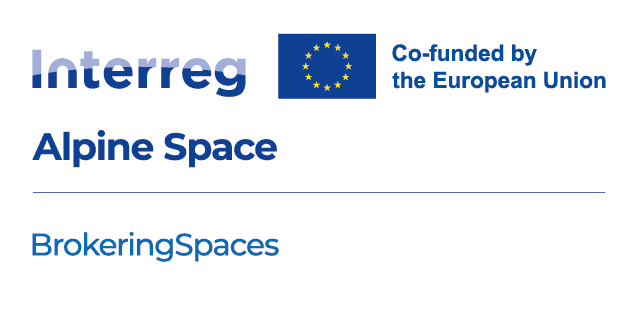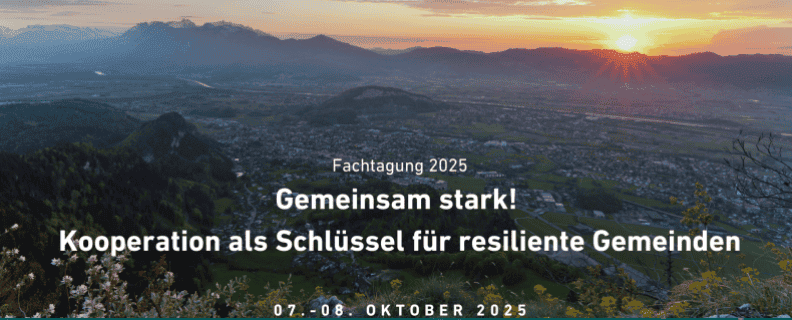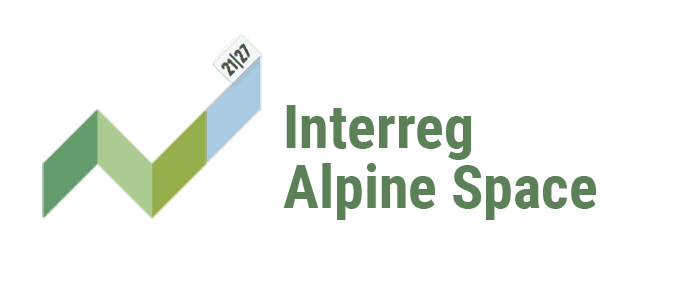
Overview
The lack of space in the Alps is causing challenges at the local level with significant socioeconomic impacts, specifically in the tourism, construction and environmental sectors. Since current approaches tackling this issue are scattered, BrokeringSpaces aims to explore the potential of integrating traditional local knowledge with regional spatial planning laws to create more specific and inclusive settlement areas. The project seeks to develop comprehensive transformation scenarios by assessing and combining legal and informal instruments.
Factsheet
- 2021 – 2027
- Cooperatively managed and developed Alpine region
- SO 4.1 - Enhancing institutional capacity of public authorities and stakeholders to implement macro-regional strategies and sea-basin strategies, as well as other territorial strategies
-
- AG6 Natural resources
- AG7 Ecological connectivity
- 692.795 EUR
- 481.796 EUR
Description
Detailed description:
In the Alpine valleys, usable land is naturally limited - so it is no wonder that conflicts over land use and function occur time and again. In addition, the scarce areas are used by different users: housing, agriculture and tourism make demands on the land. Climate change is further exacerbating the conflict over land use. How can municipalities manage to distribute the available land fairly, avoid further soil sealing and give ecosystem services the space they need?
A team of seven partners from Germany, Austria, Italy, Switzerland and Slovenia is tackling this issue over the two-year project period. The BrokeringSpaces project is part of the Interreg Alpine Spaces programme.
BrokeringSpaces: Let's negotiate the ground, not seal it!
At the beginning of the project, the existing spatial planning instruments are first collected and analysed. However, the instruments are often limited to certain levels and functions, such as building and environmental legislation at local level - there is usually no co-operation with other levels.
With the help of interviews conducted in pilot regions on the basis of a defined guideline, the first step is to find out what the awareness of land use conflicts is like. What is the situation regarding land consumption? How does the municipality pursue local development? How does it deal with the preservation of open spaces and vacant properties? What historical knowledge has been passed down about possible natural hazards? Is there a particular building culture that may have an influence on settlement development? How can building culture be reconciled with the needs of a modern society? What legislation is the municipality subject to when it comes to spatial planning? Which interest groups are involved in spatial utilisation conflicts?
The transformation scenarios and guidelines developed in BrokeringSpaces should be transferable to other institutions. For cooperation at local, regional, national and European level and a sensible spatial planning policy that takes into account the needs of all groups involved as well as nature. After all, climate change requires the creation of more space for ecosystem services and the improvement of the quality of natural resources.
Climate change as a driver
Climate change is prompting our society to give nature more space in order to utilise ecosystem services. However, our society's ever-increasing demands for personal space, space for peace and quiet in nature, intensified agriculture, mobility and the level of personal services also require space. To date, there has been no comprehensive framework for spatial planning legislation and there is often no co-operation between the groups involved.
The project aims to initiate constructive change and create new solutions for the negotiation processes surrounding the precious commodity of land. As part of the project, the partners will also focus on developing capacity-building measures for planners on the topic of integrated urban development (IUDC).
Partners
- Lead partner
- Austria
- Salzburg (AT32)
- Salzburg
- Manuela Brückler
- manuela.brueckler@salzburg.gv.at
- Austria
- Wien (AT13)
- Wien
- Cornelia Hammerschlag
- cornelia.hammerschlag@arching.at
- Italy
- Provincia Autonoma di Bolzano/Bozen (ITH1)
- Bozen
- André Mallossek
- info@plattformland.org
- Germany
- Oberbayern (DE21)
- Übersee
- Katharina Gasteiger
- info@alpenallianz.org
- Slovenia
- Vzhodna Slovenija (SI03)
- Maribor
- Tamara Korošec
- tamara.korosec@kmetijski-zavod.si
- Switzerland
- Ostschweiz (CH05)
- Zernez
- Angelika Abderhalden
- info@proterrae.ch
- Austria
- Tirol (AT33)
- Innsbruck
- Andreas Flora
- andreas.flora@uibk.ac.at
- 53.346881-6.25886
- 53.346881-6.25886
- 53.346881-6.25886
- 53.346881-6.25886
- 53.346881-6.25886
- 53.346881-6.25886
- 53.346881-6.25886
Outcomes
-
Compendium including decision-making tree for regions in need
Compendium incl. decision-making tree showcasing exemplary success in practicable use of spatial instruments & constructive cooperation of legal framework & local instruments. As the main target group is the local level, it will be designed close-to-practice. Nevertheless, it will be a relevant document for further thinking & implementation for all other target groups as well (to be respected in the introductive chapters)(Draft in RP1 (D141), updated with feedback from mid-term conference) -
Workable, practice oriented transformation scenario-scheme for local governance test regions that benefit from contributions from all governance levels and integrate land-taking sectors
This seperated output will translate the compendium (O11) into applicable workable solutions, thereby focusing on - Stakeholder-driven, co-designed elaboration of a “Transformation scenario-scheme” for the governance landscape, including new stakeholders with impact on the governance level. - Preparation of concrete, place based implementation scenarios that would be ready for implementation. Main target groups of regional to transnational level. The D221 guidelines will be included. -
Collective decision making processes to contribute to the multilevel governance of macroregional strategies
All participating partners will operationalise their membership or liasion with EUSALP AG6, AG7, PlanAlp (Alpine Convention) to promote the elaborated concepts into the working groups: - for AG6 with focus on soil - for AG7 with focus on GI - for PlanAlp with focus on the general approach as a pathway towards more sustainable, climate-adaptive resilience.
Pilots
-
Silz, Tyrol (AT)
DownloadDescription and Aim of the Pilot:
This pilot focuses on a section of the Inn Valley, situated near the Ötztal and close to Tyrol’s capital. The area hosts a significant power transformation facility, with extensive power lines dominating the landscape. The valley’s predominantly flat terrain is framed by steep southern mountain ranges and constrained on the northern side by the Inn River, limiting further territorial expansion.
Reasons for Action:
Silz is a compact settlement along an old main street, with its development shaped by historical transportation routes. Until 1984, the transnational motorway corridor ran through the city, after which it was rerouted to the north of the town. The municipality collaborates closely with neighboring towns to manage industrial zones, maintaining a balance between development and land preservation. Agricultural land remains largely undamadged and undeveloped, with local farmers resistant to land sales, and the municipal council prioritizes internal development over agricultural expansion. Silz has a notable history of urban renewal, pioneering the state’s town renewal program in 2003. Since then, it has renovated over 80 buildings, establishing itself as a leader in successful inner-city development. However, nearby municipalities have not yet implemented similar strategies. -
Ravne na Koroškem (SI)
DownloadDescription and aim of the Pilot:
The former steelworks, today functioning as an industrial zone, has left a profound footprint in the very center of a small town. Approximately one quarter of the urban area remains sealed by industrial infrastructure, shaping both the physical and spatial character of Ravne na Koroškem.
Reasons for Action:
Several tensions arise in this context. On the one hand, there is a strong push for further urban development, while on the other, the preservation of valuable agricultural land is increasingly at risk, often challenged by scattered building requests. The expansion of the town is confronted with broader spatial pressures that limit available land. A growing demand for parking spaces stands in tension with the need to safeguard existing green areas, which are vital for environmental quality and quality of life. Furthermore, local development interests frequently clash with national legislation and spatial planning authorities, creating additional layers of complexity in decision-making. Finally, the balance between private property rights and the wider public interest remains a persistent and sensitive issue that must be carefully navigated. -
Scoul, Lower Engadine
DownloadDescription and Aim of the Pilot:
This pilot focuses on managing the rapid growth of tourism-related land use, transportation, and energy infrastructure. The region is experiencing a gradual decline in landscape quality and biodiversity, alongside limited housing options for residents. The increasing number of holiday homes now represents around 60% of heritage houses. This has sparked concerns about the long-term preservation of local communities and cultural authenticity.
Reasons for Action:
The Lower Engadine region faces increasing land-use pressures driven by tourism and development, leading to conflicts of interest among stakeholders. The area is characterized by high-quality cultural landscapes, villages rich in cultural heritage, and numerous protected landscapes and habitats. Architectural styles typical of Engadine and the UNESCO Biosfera Engiadina Bassa Val Müstair highlight the region's unique identity. As the largest municipality in Switzerland in area, Scoul exemplifies the challenges and opportunities of balancing growth with conservation.
-
Balderschwang, Allgäu (DE)
DownloadDescription and Aim of the Pilot:
With a population of 385 residents and a municipal area of 41.5 km², Balderschwang is geographically isolated from neighboring German municipalities, situated behind a mountain range and maintaining stronger ties with nearby Austrian communities. The pilot aims to explore sustainable land use and tourism management strategies that address the challenges of dependency on winter tourism, environmental sensitivity, and social cohesion in an isolated context.
Reasons for Action:
Balderschwang is a renowned tourist destination heavily reliant on winter tourism, particularly snow-related activities. As a member of the Nagelfluhkette Nature Park, the area encompasses sensitive natural habitats, such as those of the Capercaillie, highlighting the importance of balancing land use with conservation. The region demonstrates that land use conflicts are not limited to densely populated areas but also occur in sparsely inhabited, high-altitude valleys. -
Truden, South Tyrol (IT)
Description and Aim of the Pilot:
Truden has already undertaken a range of participatory communal development initiatives, including the creation of playgrounds and open public spaces, as well as the renovation of vacant buildings such as the multigenerational house. As a well-developed mountain village, it nonetheless faces challenges linked to a high number of empty buildings within the settlement core.
The pilot aims to activate community participation further, explore innovative approaches to repurposing vacant structures, and strengthen the social and spatial functions of village-level public spaces. By doing so, it seeks to enhance local quality of life, promote long-term settlement vitality, and prevent further structural vacancy.
Reasons for Action:
Truden is a village with deep agricultural traditions and a rich cultural heritage, situated in a region where traditional farming increasingly intersects with expanding tourism. This creates complex demands on land use, spatial planning, and nature conservation.
As a pilot location, Truden offers an opportunity to assess how these competing interests can be balanced in practice. It provides a valuable case study for exploring sustainable strategies to preserve rural cultural landscapes, safeguard natural resources, and identify effective approaches for revitalizing vacant buildings or unsealing sealed areas. Addressing these issues is crucial for maintaining community resilience, promoting ecological integrity, and ensuring the long-term sustainability of the village. -
Saalfelden, Salzburg
DownloadDescription and Aim of the Pilot:
Saalfelden, located in the Salzburg region, has evolved from a historically dispersed rural settlement into a dynamic urban centre that serves as the cultural and economic heart of the Saalach Valley. The town’s development reflects a blend of traditional rural building forms and modern urban growth, creating both opportunities and challenges for spatial coherence and design quality.
The pilot aims to strengthen compact settlement structures, promote inner development before outward expansion, and enhance the quality of urban spaces in line with Salzburg’s Baukultur principles. It seeks to improve spatial connectivity, foster a balanced relationship between built and natural environments, and support a vibrant, livable town for future generations.
Reasons for Action:
Although an Integrated Urban Development Concept (ISEK) has been established, its implementation has so far been only partially effective. The town remains fragmented by major traffic axes, contributing to issues of land consumption and urban sprawl. As the cultural centre of the Saalach Valley, Saalfelden faces the pressing challenge of restoring spatial quality and reinforcing local identity while maintaining economic vitality and landscape integrity. The pilot offers an opportunity to translate strategic urban planning goals into tangible, sustainable outcomes that address these spatial, environmental, and social pressures.
Gallery
- Raum Innsbruck mit mit Mittelgebirge und Blick Richtung Nord-Westen - Land mismanagementVera BornemannInnsbruck with low mountain range and view in north-west direction
- Silz, Blick vom Grunberg © 2020 Land TirolLand Tirol, 2020Silz Blick vom Grünberg (c) 2020 Land Tirol
- Ravne na Koroškem © Tomo Jeseničnik, RDA Koroška d.o.o.Tomo Jeseničnik RDA Koroška d.o.o.Ravne na Koroškem © Tomo Jeseničnik, RDA Koroška d.o.o.
- Balderschwang © Marc TraubelMarc TraubelBalderschwang © Marc Traubel
- Saalfelden suburbs, photocredits Robert KrasserRobert KrasserView of the large car parks of the big supermarkets in the outskirts of Saalfelden with the "Leoganger Steinberge" mountains in the background.
- Lower Engadine view from Tarap in direction Austria© Angelika AbderhaldenLower Engadine view from Tarasp in direction Austria
Project calendar

